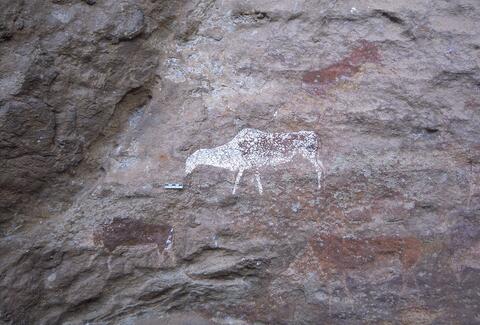Identificatie
referentie code
Titel
Datum(s)
- 13/10/2001 (Vervaardig)
Beschrijvingsniveau
Omvang en medium
Context
Naam van de archiefvormer
Biografie
Brief description of site: RSA-QUE1 is a huge south-east facing dolerite and sandstone cave. It is 30 m long, 8 m high and 6 m deep with a flat apron of land in front of it. The cave has a level surface with a few large rock blocks. There is a smaller, lower cave at the site's southern end. This site constitutes a major landmark and has been a long-term attraction for humans. It is unusual because it is dominantly composed of dolerite, while the opposite bank's krantz is sandstone. RSA-LAS, just up the river, also has an inverted dolerite bank below the sandstone. On the opposite bank is a large krantz with some shelters and faded traces of Bushman rock paintings. Vegetation grows right up RSA-QUE1.
The site has extensive and deep archaeological deposit. Could be up to 2 m in places. Visible is a hardened lens of earth that represents vitrified (Burnt) cattle dung; especially in the northern end of the site. There are up to two dozen upper and lower grindstones; made both by Bushmen and later by black farmers. In 1871 or 1872 the early traveller and explorer, George William Stow recorded one panel of Bushman rock paintings in this site. The deposit is very ashy, meaning bone preservation is good. There are any number of stone tools present. These stone tools or 'lithics' all belong to the Later Stone Age, which covers the period from about 25 000 years ago until historic times. The raw materials used for these lithics are varied. Most are opalines - a crypto-crystalline silicate rock that forms in volcanic pipes and which then occurs either as nodules in rock strata or get washed down streams. There are also hornfels (also known as lydianite or indurated shale) stone tools and this raw material is everywhere available in the form of river cobbles. Every stage of stone tool manufacture is present at Queensberry. There are cores - large lumps of rock from which stone tools are made. There are flakes - general-purpose cutting tools. Adzes are present and were used for woodworking in much the same way as a spokeshave. End and side-scrapers, often in the shape of a thumbnail were used to prepare leather. There are also rare burins and awls - used to pierce. In addition to the stone tools, there are small pieces of grit-tempered, undecorated pottery fragments. There is also some bone and charcoal and a few metal items of recent vintage. The pottery may belong to herders or early farmers who used the site.
Brief description of art: Cattle.
There are over 600 hundred individual Bushman rock paintings present; many obscured by layers of dust. There are more than two dozen cattle painted with their body decorations - in red, white, orange, red, yellow and black. These paintings have a bright, chalk-like appearance because they were painted in locally-derived hydrous ferric oxides. The deeper colours used for the eland and human figures is exotic and comes from several kilometres away. There is a red eland that has been re-painted in white paint - a rare event. Some of the imagery is painted up to 4 m above the site's present surface level while other paintings are found just above the floor level. There are two serpents in the site in red paint and one of the serpents is associated with large red, animal-headed and hooved antelope human figure or therianthrope. There are enigmatic white/black hairs on a sinuous black image, which may have a red fish associated. There are dozens of human figures and antelope; especially eland.
Naam van de archiefvormer
Biografie
Nationality: South African
Created by: willem
Created on: 11/03/2003
Naam van de archiefvormer
Biografie
archiefbewaarplaats
Geschiedenis van het archief
Directe bron van verwerving of overbrenging
Inhoud en structuur
Bereik en inhoud
Waardering, vernietiging en slectie
Aanvullingen
Ordeningstelsel
Voorwaarden voor toegang en gebruik
Voorwaarden voor raadpleging
Voorwaarden voor reproductie
Taal van het materiaal
- Engels
Schrift van het materiaal
Taal en schrift aantekeningen
Fysieke eigenschappen en technische eisen
Original size: 35mm

